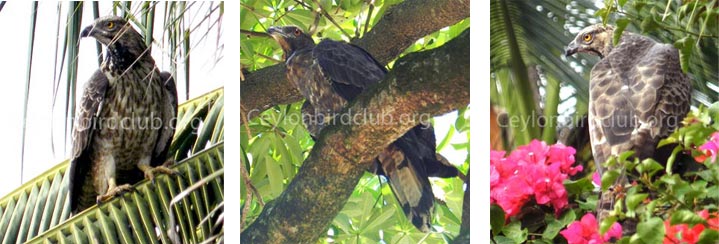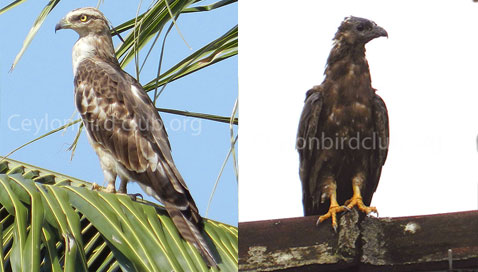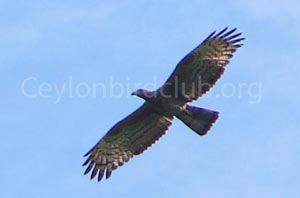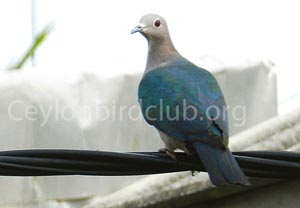


CBCN July 2013 page 149 to 154
Tharanga Herath
It is well known that birds and other wildlife observed regularly earlier in Colombo and its suburbs have declined drastically during the last decade or so due to land clearance and habitat loss.
Breeding resident bird species such as the Small White-eye, Little Minivet, Common Iora and the Grey Tit are no longer seen in most parts of Nugegoda – a major city to the South-east of Colombo. The Black-winged Kite, which was resident in the Bellanwila- Attidiya marshes have, like wise disappeared.
On the other hand two species, the Crested Honey Buzzard and the Green Imperial Pigeon, have increased their numbers in the outskirts of Colombo.
The present article is based on the sightings made during last several years in these particular areas
Sites observed
The area considered here is located in the Western Province of Sri Lanka in the wet zone. Its eastern border runs between 6°50´N and 6°54´N while its southern border lies between 79°53´E and 79°56´E. This triangular grid of the southern and south- eastern adjacent areas of the city of Colombo is focussed here while Nugegoda is given priority. Thus the whole area includes Dehiwala, Kohuwala, Nugegoda, Nawala, Pita-Kotte, Kotte, Beddagana, Talangama, Maharagama, Boralesgamuwa, Bellanwila- Attidiya & Pepiliyana.
The Crested Honey Buzzard Pernis ptilorhynchos

The The Crested Honey Buzzard Pernis ptilorhynchos, also known as the Oriental Honey Buzzard is mostly a migrant to Sri Lanka with a small resident population.
Two races of this species occur, P p orientalis (the Siberian Honey Buzzard), a scarce migrant practically impossible to separate in the field (though lacking a crest) from the other race P p ruficollis which is the commoner migrant as well as the resident sub species.
Though the Crested Honey Buzzard is a forest loving species it has been observed flying over Nugegoda and its environs between 2006 and 2008. Recently, especially since 2010-2011, a definite increase has been observed birds being observed perched rather than just flying over, suggesting that they may be resident in the area though breeding has not been observed.
It is noted that most of the times, these birds when perched, and sometimes when in flight are harassed by the resident birds of the area. They include the White-bellied Drongo, Crows, Magpie Robin, Rose-ringed Parakeets and even Common Tailorbirds and Purple-rumped Sunbirds appeared to get excited with the approach of this raptor. The alarm calls made by the Common Palm Squirrels and Southern Common Babblers, provide a good opportunity to observe the arrival of this bird.

Of the many times I have observed the species in the area I have been able to study them closely on several occasions while they were perched at various sites in Nugegoda. Their plumage patterns showed that they were different individuals including an adult male with dark plumage and red eyes.
Member Jagath Gunawardena too mentioned that he has observed the species in his well wooded garden situated in the heart of Nugegoda town.
Among the sites mentioned earlier, the highest number of sightings were made in the Belanwila – Aththidiya marshes and surrounding areas.
Due to the many variations that occur, plumage colour is not of much help in identifying the species.
Features which help to identify the Crested Honey Buzzard from other raptors are, provided a good view is obtained, the small ‘pigeon like’ head, closely feathered lore, downward sloping short gape and the eyes which are set relatively further back than in other typical raptors
 Another very clear distinctive characteristic, which can be used to separate it from other similar raptors except those of the genus Baza, is the linear nostrils of the genus Pernis (Legge,1983) which are located in a relatively larger cere. This is one of the best characteristics which help in distinguishing it from an immature Crested Hawk-Eagle when the former appears identical in colouration to the latter. In the latter and the rest of the genus Spizeatus,the nostrils are large and oval in shape (Legge,1983).
Another very clear distinctive characteristic, which can be used to separate it from other similar raptors except those of the genus Baza, is the linear nostrils of the genus Pernis (Legge,1983) which are located in a relatively larger cere. This is one of the best characteristics which help in distinguishing it from an immature Crested Hawk-Eagle when the former appears identical in colouration to the latter. In the latter and the rest of the genus Spizeatus,the nostrils are large and oval in shape (Legge,1983).
The culmen curves gradually from the base; there is no abrupt hook at the tip (Legge, 1983). The beak lacks a festoon (Legge, 1983), which occurs in many other raptors- e.g. in the case of hawk-eagles- a useful feature when in the hand .The stout tarsi are bare apart from the upper half, which is plumed in front (Legge,1983), whereas in similar plumaged hawk-eagles they are long and clothed.
In flight the long tail, smaller head with longer neck are useful identification features. The tail when folded, appears usually as ‘two feathered’, which suggests a wedge shaped body with a slight fork to the tail. Birds with white underparts show some fine black streaks, which could be black streaks on a brown background.
Green Imperial Pigeon Ducula aenia
 As with the Crested Honey Buzzard, the Green Imperial Pigeon is another species which has greatly increased in numbers in Nugegoda and surrounding areas during the past decade. Whereas earlier, birds were seen flying over only, I saw seven birds perched on the 7th of February 2011 for the first time. Since then, they have been observed frequently, even perched at times on power lines. Its deep calls often draw attention to the bird.
As with the Crested Honey Buzzard, the Green Imperial Pigeon is another species which has greatly increased in numbers in Nugegoda and surrounding areas during the past decade. Whereas earlier, birds were seen flying over only, I saw seven birds perched on the 7th of February 2011 for the first time. Since then, they have been observed frequently, even perched at times on power lines. Its deep calls often draw attention to the bird.
Usually this is a bird commonly seen in forest and well wooded country. The increased growing of an ornamental palm with red berries (called ‘Dothalu Puwak’ in Sinhalese) in house gardens appears to attract these birds to them.
Once an aerial display was seen, performed by a bird that flew with two other birds in August 2013 in Nugegoda. So far, the author has not been able to make any observations on the breeding habits of this species.

CBC Member Hasitha Perera informed me, based on the photographs taken by another observer, of a record of a pair carrying nesting material at a site between Nugegoda and Kohuwala, though nest making had been abandoned before completion.
As the birds are seen throughout the year without much fluctuation in numbers, it is quite possible that the birds breed in Nugegoda and the surrounding areas.
Acknowledgements
I thank Messrs Jagath Gunawardana, Divanka Randula, Suneth Kanishka and all other members of the bird group of the Young Zoologists’ Association who were with me during field visits to Bellanwila- Attidiya and Kotte- Beddagana marshes. I appreciate the interest shown by my neighbours, on these birds.
References:
Harrison, J. and Worfolk,T. (1999); A Field Guide to the Birds of Sri Lanka, Oxford University Press, Oxford.
Henry, G.M. (1998); A Guide to the Birds of Sri Lanka-3rd Edition, Oxford University Press, Delhi
Herath, T. (2008- 2013) In: Ceylon Bird Club Notes.
Kazmierczak, K. and van Perlo B. (2000); A Field Guide to the Birds of The Indian Subcontinent, Pica Press, Sussex.
Legge, W.V. (1880); A History of the Birds of Ceylon- 2nd edition (1983).Vol I&III, Tisara Prakasakayo Ltd, Dehiwala, Sri Lanka.
MOE 2012. The National Red List 2012 of Sri Lanka; Conservation Status of the Fauna and Flora. Ministry of Environment, Colombo, Sri Lanka.
Rasmussen, P.C. & Anderton, J.C. 2005; Birds of South Asia The Ripley Guide.Vols. 1 & 2.Smithsonian Institution and Lynx Edicions, Washington, D.C. and Barcelona.
Warakagoda, D. Inskipp, C. Inskipp, T. & Grimmett, R. (2012); Birds of Sri Lanka, Christopher Helm, London.
[ Editors’ Note - The editors are of the opinion that it is relevant to mention two other species other than the above species that has expanded its range and are now seen in around Colombo and its suburbs. One is the Spotted Dove that is becoming increasingly common in the said areas where it was non existent about two decades ago and the other is the White-bellied Sea Eagle which is now commonly seen in Malabe, Kotte and Rajagiriya and has been reported on a number of occasions circling over the city of Colombo. Outside Colombo the Indian Peafowl is on a steady increase as well. It would be a fascinating study to find out the reasons for such expansions as well as the decreases in the populations of some other species.]